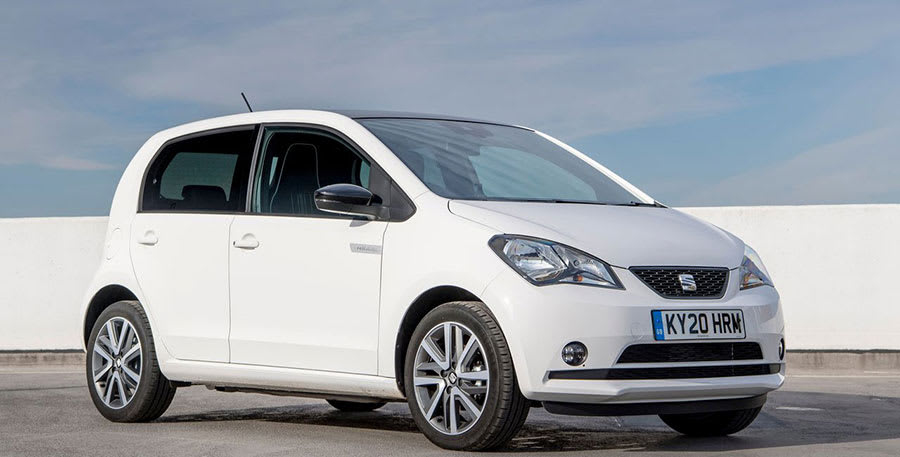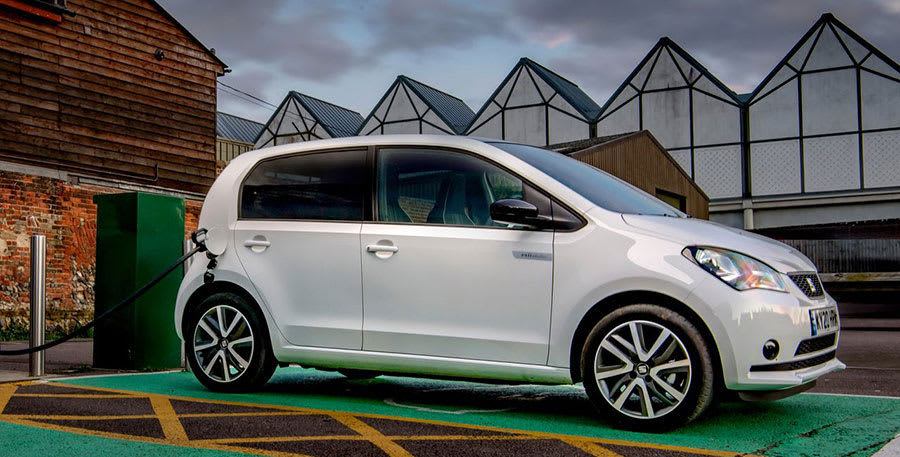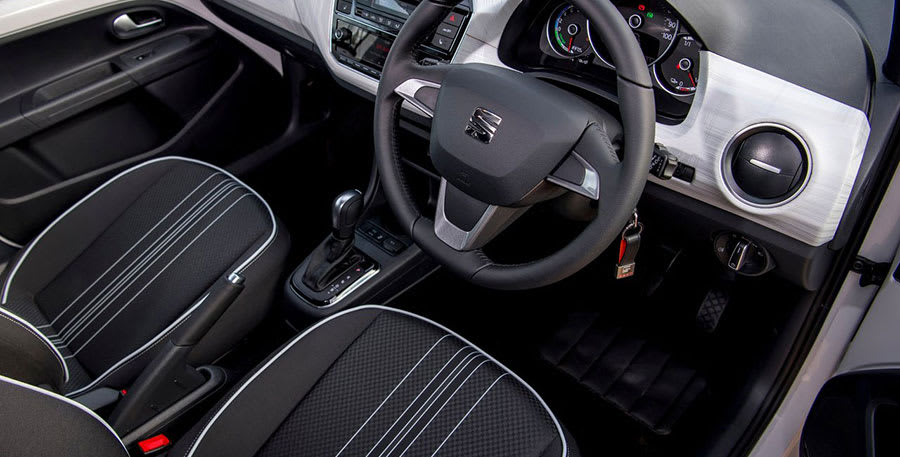.jpg)
Seat Mii Electric Review
.jpg)
Introduction
The Seat Mii has been around for a while now, but it’s still one of the best city cars you can lease. Sharing much with the Volkswagen Up! and Skoda Citigo, it mixes style, practicality and economy into one pint-sized, fun-to-drive package. But now the Mii has swapped petrol engines for electric power, and it’s only made the already appealing hatchback even more compelling.
Review Sections
Select's rating score* - 3.9 / 5
At a Glance
With electric power replacing the old, underpowered petrol engines, the Mii has become a sparkling example of what a city car should be. It’s small and nippy, which makes traffic less of a chore, and it’s surprisingly good fun to drive if you venture into the countryside. The range isn’t huge, but it’s more than enough for a bit of urban commuting, shopping trips and school runs.

Of course, it’s designed to be a second car, rather than primary family transport, but you might find yourself using it more than you expect. Unless you have to do a long trip or carry lots of things, the Mii Electric will do the job with endearing charm. And because there is no engine to burn fuel and no tailpipe to pump emissions into the atmosphere, it’s a cheap and guilt-free way of getting from A to B.
Key Features
Aside from the perky performance of the electric motor and the abandon with which you can throw this car at a corner, the most surprising aspect of the Mii Electric is its practicality. Sure, the Hyundai i10’s boot is marginally bigger, but the Mii is every bit as spacious as its petrol-powered counterpart. It’s even more spacious than the likes of the Toyota Aygo.
And cabin space isn’t bad either. Tall adults will find it slightly claustrophobic on long journeys, but that’s not what the Mii is for. If you’re zipping down the road to watch your local football team or taking the family to the cinema, the Mii will be perfect. As runabouts go, it doesn’t get much better.

Range & Batteries
The Mii comes with a 36.8 kWh battery that sits under the rear seats, giving you an official range of between 155 and 160 miles on a single charge. However, Seat claims you can increase that to around 220 miles if you only drive around in town and use the regenerative braking function, which harvests energy while you’re braking or coasting to a halt.
Generally, we found the Mii’s range was quite accurate, with about 150 miles proving quite achievable if you drive sensibly on a mix of roads. That should be more than enough for a few days’ worth of school runs, commutes and trips to the supermarket – certainly if you live in suburbia.
Performance & Drive
The Mii’s electric motor produces just 83hp, but that’s more than enough for such a small, light car. In fact, it’s more powerful than the petrol versions once sold on these shores. Officially, the sprint from 0-62mph takes a little over 12 seconds, which is actually quite sprightly for a little hatchback. A petrol-powered Toyota Aygo takes almost 14 seconds to manage the same feat.

But the really impressive figure is the 0-31mph dash. That takes just 3.9 seconds, which is pretty sprightly for a little Seat Mii. Even a hot hatchback would have to push hard to rival that kind of performance off the line. Unfortunately, the Mii rather runs out of steam as you get faster, and it’s all out of ideas at 81mph. But when was the last time you did 81mph in the middle of Reading? This is a city car, and it’s designed for drivers who will hardly ever take it on a motorway.
To that end, the Mii is the consummate city slicker. The instant response of the electric motor is ideal for nipping around town, and the big windows (everything is relative) mean visibility is good for something in this class. It’s quiet and easy to drive, while the tiny dimensions make it simple to park and manoeuvre. All of which makes urban driving as relaxing as it possibly can be.

That said, the Mii is impressively composed if you do venture onto a faster A-road or motorway. Performance is more than adequate, and it’s quite happy to sit at 70mph, although doing so will eat away at the range. Even the ride is good, with the suspension easily soaking up all but the very worst bumps in the road.
But the Mii is even better on a back road, where the surprisingly well sorted chassis comes into its own. The battery pack is housed low down in the car, so it manages the extra weight well, and the wheels are all at the corners, giving the car great agility. The manoeuvrability that makes this car so good around town also makes it good fun on your favourite country road.
Charging
How quickly you can top up the Mii’s battery will depend on what sort of charger you have access to. If you’re at home and you have a dedicated 7.2kW ‘wallbox’ charging point (not to be confused with a three-pin, 13-amp socket), you can charge to 80% in four hours. And if you use a 40kW public charging point, you’ll manage the same feat in just one hour. Get that amount of juice on board and you could get from empty to around 120 or 130 miles of range in just 60 minutes.

Running Costs & Emissions
With electric power under the bonnet, running costs are going to be kept right down. If you can find a good electricity tariff and charge at home overnight, ‘fuel’ costs will be minimal. Even charging away from home isn’t ruinous, although it’s worth investing in some charge point memberships if you plan to do it regularly.
If you’re looking at a Mii Electric as a company car, things get even cheaper. Thanks to the government incentives for electric vehicles, you’ll pay just 1% company car tax in the 2021/22 financial year. And given the Mii only costs around £20,000 to buy, that’s going to be a tiny, tiny amount of money leaving your bank account.
Interior & Technology
The Mii’s interior is very good for a car in this class, although profit margins are tight in the small car world, so certain parts are built down to a price. You’ll find a few hard pieces of plastic hanging around, and some of the fixtures and fittings feel a little bargain basement when compared with the larger Seat models. But for all that, the build quality is generally excellent. Everything is screwed down properly, and none of the switchgear feels as though it might come off in your hand.

But in places, the Mii betrays its age. The Electric version may be a relative spring chicken, but the standard Mii has been around for about a decade. That shows in the Mii’s old-school instrument cluster and the tiny infotainment screen, but the biggest oddity is the ignition key. Of course, there’s nothing unusual about using a key to start a car, but it feels very out of place in an electric vehicle.
Fortunately, some of the other tech on show is much more modern. The cradle at the top of the dashboard holds your phone, allowing you to turn it into a touchscreen infotainment system. Through the Drive Mii app, you can access TomTom satellite navigation (Google Maps is better) and you get some trip computer information. You get access to the car’s media system, too. All in all, it’s a clever, cost-saving system that reduces the need for a proper eight- or nine-inch touchscreen, but you can’t help thinking a proper screen would be better.
Practicality & Boot Space
Despite measuring just over 3.5 metres in length and having a big battery pack under the floor, the Mii Electric is surprisingly spacious. Of course, it’s no Rolls-Royce in there, but even tall drivers will be able to get comfortable up front, with bags of headroom and a reasonable amount of space between the front seats.

The switch to electric power has seen the rear seats raised up slightly, but there’s so much headroom on offer that only the very tallest passengers need worry about it. The bigger issue is legroom, which was never that generous in the petrol-powered car. Nevertheless, you can fit four six-foot adults in a Mii quite comfortably, although longer trips might be a little less pleasant with four on board.
But the Mii is designed for short trips, such as the school run, and kids will be perfectly comfortable in the rear seats. They’ll have space to stretch out and squabble, and their various bags will fit in the impressively large boot. Officially, the Mii Electric’s boot measures 251 litres, making it only slightly smaller than that of a Ford Fiesta. And if you fold the rear seats down, you get 959 litres of space – far more than you’ll find in a petrol-powered Peugeot 108 or Toyota Aygo.

Safety
Small cars often struggle slightly in the Euro NCAP crash test, and the Mii Electric is no exception. It shares its three-star score with competitors such as the Volkswagen e-Up!, Fiat 500 and Hyundai i10, although Seat arguably has the right to feel slightly aggrieved.
The Mii scored quite well for adult and child occupant protection, hitting 81% and 83% in the two respective categories. Those scores are better than the four-star-rated Peugeot 108 (80% and 80%) comparable with the larger Renault Zoe (89% and 80%), which managed to achieve a five-star rating. The car was just let down slightly by its protection of vulnerable road users and its lack of safety assistance tech. Nevertheless, the Mii is a relatively safe choice when compared with other cars in its class.
Options
Specifying your Mii Electric is a pretty simple affair, with just one trim level on offer. Standard equipment includes 16-inch alloy wheels, LED daytime running lights and tinted rear windows, while the cabin is adorned with heated front seats, air conditioning and a leather-trimmed steering wheel.
You also get a clever cradle that will hold your smartphone, allowing you to plug in and integrate your personal tech with the car. It’s all done through the Drive Mii app, which gives you satellite navigation, trip computer integration and the ability to control the car’s media system using your phone.

Other handy inclusions that aren’t always present in city cars include heated front and rear windscreens, rear parking sensors and automatic lights and wipers. You also get a 10-year subscription to the Seat Connect app, which can tell you where you’ve parked, whether the doors are locked and whether you’ve left a window open.
It isn’t a bad selection of standard features for a car that’s essentially a tiny, cheap-as-chips city runabout. But Seat isn’t offering any optional extras, apart from the paint. You can have the usual black, white and grey suspects, or you can have the more eye-catching red and blue paint colours. All but the black are offered in combination with a black contrast roof, if that’s your kind of thing. Otherwise, you can have the whole car painted in just one shade.

Rival Cars
The old, conventional Mii was up against a plethora of petrol-powered city cars, including the Fiat 500, Toyota Aygo and Ford Ka. But the electric hatchback market is slightly smaller, so the list of competitors has shrunk. The new Fiat 500e is a stylish alternative, while the slightly larger Mini Electric is also one for the fashion-conscious. It doesn’t have the range of the Fiat or the Seat, though. The Renault Zoe is the more practical choice, and it has the best range of the bunch.
But the Mii Electric’s biggest rivals are much closer to home. Sister brands Volkswagen and Skoda make mechanically identical models called the e-Up! and Citigo-e iV, which feature only minor external modifications. Otherwise, the three cars are almost exactly the same, and that makes choosing between them quite tricky. We’d advise checking out the deals on all three, then making your decision on that basis.
Verdict & Next Steps
The Mii remains up there with the best city cars on the market, and an electric version will make a lot of sense for many. The only thing muddying the water is the presence of its identical siblings – the Volkswagen e-Up! and the Skoda Citigo-e iV – both of which have all the same qualities.
Picking your favourite will largely come down to personal preference, but whichever you choose, it will be the perfect second car or urban runabout.
Where to next?
View latest Seat Mii leasing deals - guide price from £116.13 per month inc VAT**
Looking for a great leasing deal? Check out our incredible range of car lease deals
New electric vehicle? Read our latest Reviews and find the right model for you
Want to know more about leasing? Take a look at our comprehensive Leasing Guides
Interested in everything motoring? Why not catch up on all the latest Car Leasing News.
*Score based on Select’s unique meta score analysis, taking into account the UK’s top five leading independent car website reviews of the Seat Mii Electric
**Correct as of 29/06/2021. Based on 9 months initial payment, 5,000 miles over a 48 month lease. Initial payment equivalent to 9 monthly payments or £1495.15 Ts and Cs apply. Credit is subject to status.

.jpg)
.jpg)















